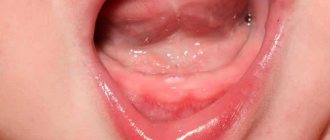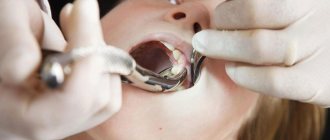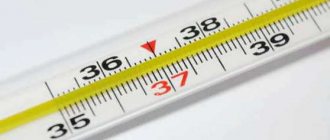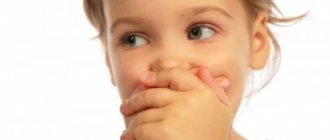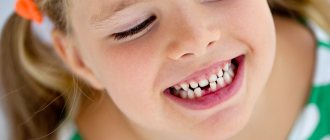Temporary teeth
Timing of teething
Dental buds are formed during the period of intrauterine development. The eruption of the first teeth begins at the twenty-fifth week of the baby’s life. The lower incisors appear first, followed by the upper ones by eight months. The age at which baby teeth, called premolars, erupt varies from one to two years. The last to appear are the canines and second premolars, which occurs from sixteen to thirty months.
This teething schedule is optimal, but it is impossible to determine the exact timing. The process depends on the characteristics of the child’s body, the health of the mother during pregnancy and genetic factors.
Timing of teething in children in the table
| Type of tooth | Lower jaw | Upper jaw |
| Medial incisor | 6 – 10 months | 7 – 12 months |
| Lateral incisor | 7 – 16 months | 9 – 13 months |
| Fang | 16 – 23 months | 16 – 22 months |
| First premolar (baby molar) | 12 – 18 months | 13 – 19 months |
| Second premolar (baby molar) | 20 – 31 months | 25 – 33 months |
The order of teething in children
The teeth follow the principle of pairing, for example, if one fang appears, a second one should be expected soon. The sequence of teething is determined by nature based on the practical significance of dental units for survival.
The front teeth of the lower row grow first, then the upper ones come. The lateral incisors disrupt the order of teeth eruption; their appearance begins with the upper jaw. Then comes the eruption of chewing teeth - the first premolars. The last to emerge are the canines and molars. The process of teething in children is completed by the age of 2-3 years.
Diagram of baby teeth eruption in children
How many teeth should a child have at 3 years old?
All twenty baby teeth appear by about 2-2.5 years. It includes eight incisors and molars, as well as four canines. By this time, they are erupting, including in the wrong direction, but by the age of three, in most cases they occupy a normal position, since the child is actively chewing food.
If by the age of three a boy or girl does not have a full set, do not panic. This may be an individual characteristic of the child. To be sure, it is advisable to consult a pediatrician and dentist to clarify the cause of the delay and rule out rickets, metabolic disorders or endocrine diseases.
Permanent teeth
Timing of teething in children
The first permanent teeth appear several months before the baby teeth fall out—the molars, or “sixes,” erupt. This occurs at the age of six. By the age of eight or nine years, it is the turn of the incisors. When a child is ten to twelve years old, premolars and canines erupt. Next come the second molars, the eruption of molars is completed by adulthood.
Important!
Wisdom teeth appear much later, after twenty years. However, their complete absence is also the norm.
Timing of teething in the table
| Name | Lower jaw - time of eruption | Upper jaw - eruption time |
| Medial incisor | 6 - 7 years | 7 - 8 years |
| Lateral incisor | 7 - 8 years | 8 - 9 years |
| Fang | 9 - 10 years | 11 - 12 years |
| First premolar | 10 - 12 years | 10 - 11 years |
| Second premolar | 11 - 12 years | 11 - 12 years |
| First molar | 6 - 7 years | 6 - 7 years |
| Second molar | 11 – 13 years | 12 - 13 years old |
| Third molar | 17 – 21 years old | 17 – 21 years old |
Teething order
The pairing principle also applies to permanent dental units. The correct sequence of teething is important for the formation of the bite; it is necessary to carefully monitor the time of loss of baby teeth and the order of growth of molars.
The lower molars appear first, then the upper ones. Next, the temporary teeth of the lower jaw fall out, the permanent teeth erupt, and only then the upper dental units are replaced.
This schedule for teething in children is not universal, but if there are significant deviations, you should consult a specialist.
What teeth appear first in children?
The rudiments of baby teeth and even some molars begin to form at the stage of intrauterine development, so modern diagnostic technologies make it possible to track this process and prevent some deviations. After birth, the first teeth usually begin to erupt when the baby reaches six months of age. This means he will soon be ready to eat more solid foods. In the vast majority of cases, the incisors appear first: as a rule, the lower central incisor becomes the “pioneer”.
Signs of teething
Symptoms of teething in infants
The appearance of baby teeth is a little more difficult than that of permanent teeth, since the baby has not yet encountered pain and cannot understand what is happening to him. Teething in children under one year of age is accompanied by the following signs.
- The most common symptom of teething is fever. An increase to 38 degrees within three days is normal.
- Swelling of the gums. Often, when children are teething, their gums swell, their sockets itch, and they have a desire to chew hard objects. It is important to prevent the child from damaging the mucous membrane; it is better to buy a special teether to relieve discomfort.
- Decreased appetite. Children refuse to eat due to stress or itchy gums.
- Teething syndrome. Neurosis, tearfulness, anxiety, poor sleep and whims may indicate the imminent appearance of the first tooth, even if the child does not experience pain, fever or swelling of the gums.
Important!
An increase in white blood cell levels during teething should not be a cause for alarm. This is a common occurrence associated with a weakened immune system.
Symptoms of eruption of permanent teeth
A change in temporary bite is accompanied by other unpleasant sensations. The process has the following characteristics.
- Root resorption and loss of baby teeth. A sure signal of the appearance of a new tooth in the coming months.
- Increase in jaw bone size. Permanent teeth are larger than baby teeth, the jaw grows, creating conditions for a change in bite.
- Pain in the gums. Redness and swelling of the mucous membrane are a reaction to teething.
Important!
Body temperature above 38 degrees, cramps, refusal to eat and difficulty breathing are not symptoms of the appearance of milk and permanent teeth. These are signs of an infectious disease. It is necessary to urgently consult a doctor.
After a year, teeth appear with the following frequency:
- by 12-15 months – two pairs of first molars erupt;
- by 18-20 months – a pair of upper and a pair of lower canines are already clearly visible;
- 20-30 months is the period of appearance of two pairs of second molars.
How many teeth should a child have at 1 year 3 months? Ideally 12, but the number can change in one direction or the other, and this is not considered a deviation. The frequency of teething is influenced by many factors, including previous infections, heredity, climate, and health status.
The question of how many teeth a child should have at 1 year 8 months, or 20 months, also cannot be answered unambiguously. The answer will be approximate - about 16. Up to a year, parents should focus on the approximate formula: the number of months minus 4, with a reservation for the baby’s characteristics.
Painful teething: advice for parents
When faced with teething in children, many parents are at a loss. First of all, you need to call an ambulance and determine the reason for the baby’s poor health. If symptoms are confirmed, the specialist will prescribe medications for teething - antipyretics and painkillers.
You can treat your gums yourself with an anesthetic gel with a cooling effect to reduce itching and swelling of the mucous membrane. Ice will also help. To reduce gum irritation, there are special silicone fingertips made of hypoallergenic material.
Folk remedies for teething will effectively relieve painful sensations - a decoction of chamomile, sage, tincture of valerian and honey will soothe inflamed tissues.
Painkillers for teething are contraindicated in children; this can worsen their health.
Important!
Without a doctor's recommendation, antibiotics and other strong teething medications can cause an allergic reaction.
What are baby teeth?
A child may believe that baby teeth are needed only so that the Tooth Fairy has something to build her snow-white castle from. But adults should know the truth. When a child is still very small, his head, and therefore his jaw, are small. If the baby, instead of milk teeth, began to cut molars immediately, they would not fit into the mouth either in size or in number. Therefore, nature gave us a temporary solution for the first ten years.
There are 20 primary teeth in total (10 each on the upper and lower jaws). These are incisors - central and lateral, canines, and molars. Usually, a child already has all of them at the age of 3-3.5 years.
Milk teeth differ from primary teeth not only in size, but also in structure. The enamel of primary teeth is approximately 2 times thinner and not as rich in minerals. Therefore, the child needs to carefully monitor oral hygiene - caries on baby teeth develops very quickly. Milk teeth have thin not only enamel, but also the layer underneath it - dentin - so caries quickly develops into pulpitis. Baby teeth have both nerves and roots, but they are shorter than molars. The latter gradually “dissolve” during the period of change of bite. This is why the teeth begin to loosen.
If baby teeth are not taken care of and treated, the child’s gums may become inflamed, and the embryos of the molars may suffer or die. Don't leave caries unattended!
Deviations in teething
Minor changes in the timing and sequence of dental growth should not cause alarm. However, significant deviations from the norm in teething are a cause for concern.
- The tooth does not appear for a long time. Reason: genetic predisposition to long eruption or lack of rudiments.
- Too early appearance of teeth. Caused by disruption of the endocrine system.
- Black or brown enamel surface color. Indicates high iron levels, poor salivation, or chronic inflammatory processes in the child’s body.
- Incorrect row position. Bite pathologies indicate a hereditary factor or deformation of the maxillofacial bone.
Tooth growth abnormalities in children
Unfortunately, the development and growth of teeth in children does not always occur as expected: there are a number of anomalies of various types that in one way or another affect the aesthetics and/or functionality of the teeth.
Causes of impaired growth and development of teeth:
- bad heredity;
- fetal injury during pregnancy or birth; intrauterine growth retardation, infections and so on;
- disruption of the endocrine system, thyroid dysfunction;
- lack of vitamins and minerals;
- mechanical, thermal and chemical injuries to teeth;
- bad habits in children that can affect the formation of teeth;
- lack of proper hygiene and poor diet.
Below is a table that describes the most common types of dental anomalies in children.
| Anomaly class | Description |
| Size of teeth | There are microdentia (too small teeth) and macrodentia (too large teeth). The anomaly can affect one or several teeth (and even the entire dentition). |
| Number of teeth | There is partial (lack of several teeth) and complete (absence of all teeth) adentia. Hyperdentia is a supernumerary set of teeth (usually in the second row). |
| Shape of teeth | Cone-shaped, barrel-shaped (Hutchinson's teeth), Pflueger's teeth (the neck is more developed than the coronal part). |
| Anomalies in the structure of enamel and dentin | Hypoplasia (spots and grooves on the body of the tooth), hyperplasia (tubercles, enamel drops, etc.), dentinogenesis imperfecta (violation of the structure and color of dentin). |
| Color irregularities | Enamel pigmentation (gray, black, amber enamel color). Most often it is caused by a disruption of the immune system during the prenatal stage of development. |
| Malocclusion | All types of dental malocclusions: mesial, cross, open, deep and so on. |
Despite the fact that some dental anomalies in children are quite serious, a timely visit to the dentist will help you avoid problems and maintain the health and beauty of your smile. If you let the situation take its course, unpleasant consequences will not keep you waiting.
Possible damage to small molars
Carious lesions of primary and molar teeth in children are observed quite often. This is due to the bumpiness of their surface, which can trap food particles and bacteria. Since children at an early age do not always actively and correctly brush their teeth, these residues can lead to damage to the enamel and deeper spread of caries.
Depending on the degree of damage, caries can penetrate either exclusively into the enamel, or into dentin or even cement. In the latter case, we are talking about deep caries, which often requires serious treatment or even tooth extraction.
Another variant of damage is a change in tissue structure, which may be associated with metabolic disorders in the human body or other diseases. Such a disease can also be the result of poor nutrition or constant diets, in which the body does not receive enough nutrients.
At any age, a person can experience excessive tooth wear, which leads to the destruction of enamel and can cause other serious damage. Teeth can wear down in different situations, such as:
- if a person has bad habits of grinding his teeth, etc.;
- in case of improper or insufficient nutrition;
- in the presence of diseases of the endocrine system;
- due to a genetic predisposition to enamel depletion.
All of these lesions can be the result of both an incorrect lifestyle and various diseases or heredity. Regardless of the reasons, it is necessary to begin treatment of emerging injuries immediately so as not to aggravate the process.
Maxillary premolars
The crown of the premolars on the upper dentition has a prismatic shape. The buccal and palatal bones often have a convex surface. The first and second premolars in the row also have their differences.
First premolar
The difference between the first premolar of the upper jaw is the predominance of the vestibular surface over the palatal surface. Its contact surfaces are rectangular in shape. The buccal tubercle has two distinct slopes. The root of such a tooth often has a bifurcation.
Second premolar
In such a tooth, the buccal surface usually predominates over the palatal surface, which is more rounded. In most cases, this premolar tooth has a single cone-shaped root. However, there are also cases when it has a split.
Features of the structure of molars
Molars have a characteristic structure. On the upper jaw they have three roots and four canals. The lower jaw has two roots and three canals. Moreover, the number of canals also differs depending on the location of the individual tooth. Thus, the first of them often have one more channel than the next two.
The main characteristic feature of this type of teeth is the area of their chewing surface. They bear the heaviest load when chewing food particles. The molars themselves also have differences among themselves, which are associated with the structure of the jaw.
Physiological features of the development of baby teeth
The front, or frontal, teeth are located very tightly to each other and only when the child reaches the age of four, diastemas become visible between them - physiological gaps that increase after a year or two against the background of jaw growth. If there are no diastemas at the age of six, this indicates insufficient jaw growth, leads to crowding and requires correction of the bite in children. Physiological abrasion of surfaces, which contributes to the timely development of the masticatory apparatus, begins at three years of age.
